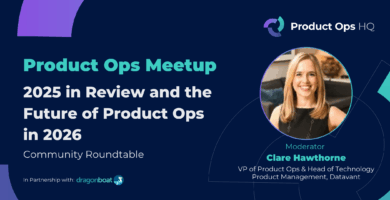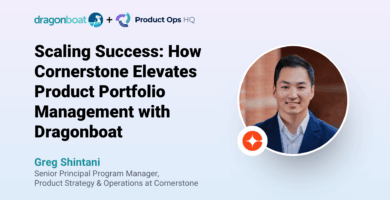Events • On Demand | Watch Time: 55 Min
Fireside Chat with Product Operations Pros
Hiring for product ops? Just started in the role?
Building out the function and want to know what’s worked and what hasn’t for others in your position?
Product operations exists to build effective product organizations that achieve the best portfolio outcomes. From building and training the team to improving and implementing processes and managing tooling for all stakeholders, product ops plays a critical role in driving outcome-focused product organizations forward.
Watch 3 product operations professionals, Becky Flint (CEO & Founder of Dragonboat), Jackie Orlando (Director of Product Operations at Tealium), and Diana Soler (Senior Product Operations Manager at AppDirect) discuss a day in the life of product operations.
Some of the topics include:
- The evolution (and career path) to product operations
- How to build and scale product ops
- How to make product ops a strategic function within the product organization
- What KPIs to use to measure success for product ops
About the Speakers:
Becky Flint built and scaled product portfolio management at PayPal, Bigcommerce, Shutterfly, and Feedzai. She is the founder of Dragonboat, an integrated product portfolio platform that helps product teams strategize, prioritize, deliver and improve industry-leading products.
Jackie Orlando has strategic leadership experience at Digitaria and Mirum Agency where she streamlined planning and decision-making to empower teams to achieve organizational and client goals. As Director of Product Ops at Tealium, Jackie helps the product org drive business outcomes.
Diana Soler previously worked at Airbnb as a program manager before moving to AppDirect to lead product operations. Her experience in product marketing, project management, and customer communication has allowed her to create programs that scale through cross-functional collaboration.
Transcript
The following transcript has been altered for readability.
Becky Flint: I want to start with a why question. Why did your company build a product operations function?
Jackie Orlando: I was a little bit lucky out of the gate, it wasn’t a difficult conversation. We had leaders that recognized this need for operations in order for us to continue to scale and grow. So it wasn’t, “Do we do product operations?” It was “How do we do it? And who are the right people to be doing it? And how does it fit within the organization of Tealium?”
At first, I was sitting underneath the enterprise product arm within the product organization. And when my current boss came in as VP of product, he recognized even greater of a service that product operations could provide to all of the groups within product work, as well as, all the tentacles that reach out and interface with a product organization. And so he made it official. He pulled me out from underneath enterprise products and established my title as product operations director. It wasn’t a difficult thing. But I think the ‘why’ behind product operations is finding the most efficient, effective ways to scale and grow at the rate that you want to. And so if you don’t invest in that area, you’re going to be behind the game.
Diana Soler: At AppDirect, the product team today consists of 20 product managers and 6 product directors. So over the last few years, the company has been scaling quickly. I read recently that approximately 95% of b2b companies now offer a subscription-based product and our teams are empowering that platform to help our enterprise customers build and launch a digital ecosystem. So you have a reason why the company is growing quickly.
As the company is growing, as the team is expanding, we are releasing features on a weekly basis. So they needed someone to come in to create the policies and procedures to promote that operational excellence. They also need help throughout the product development lifecycle, helping the team optimize its product launch readiness and introduction process.
The role of product operations was evangelized by the Vice President of Product. And he’d been thinking about this for several years. And it wasn’t until recently that he identified product operations that they found me and brought me in.
Becky Flint: I experienced something very similar. 17 years back, the term was new, but the role was not new. It’s like program management.
At PayPal, we were expanding quickly and growing internationally. And at that time, product managers had so many challenges just working with each other. So over the years, you realize that product operations drives efficiency and collaboration. But ultimately, I think product operations helps organizations drive outcomes that work with all the factors associated with that.
Diana Soler: Yeah, when I came in, one of the things I needed to quickly understand is not only where product management needed product operations but also what are the needs. It was about building the why and showing the value and building those bridges of collaboration with those leaders. That helped me identify what product operations is. And although today we’re outcome-driven, in the future, I need to be data-driven.
Jackie Orlando: I would completely agree with that. When I first started, our focus was executional rigor. But as we get our footing with that, and Dragonboat is helping us with that a lot, we need breathing room to now focus on those outcomes. For example, how do we manage up to senior leadership to give them visibility on how they’re spending their money?
Becky Flint: Yeah, I think that makes a lot of sense. Could you expand on some of the biggest challenges you were facing?
Jackie Orlando: First and foremost it was executional rigor. We had a pretty big engineering team working on some amazing stuff, not quite as organized as it could have been. So we helped to establish Scrum. And to get the JIRA tool up and running with our engineering operations partners.
And then the second biggest task that was asked was the launch process. You know, launch being not just we’re code complete, but how do we interface and collaborate with all of our marketing partners, our sales, our support. Basically, everyone needs to be enabled to make sure they have the right training, processes, communication plans, etc in place. And then transparency and confidence. How do we tie those two things together and provide visibility, but also gain the confidence of those partners and our ability to deliver?
Diana Soler: Absolutely agree with Jackie. Because I am a team of one right now, I needed to learn the biggest issues facing our customers. That includes both internal customers, customer-facing teams, and also external customers. And then once I understood those friction points, I needed to prioritize my work and identify where I was starting. So I needed to map what I was going to be working on. Additionally, I had to prioritize it, to tie it to what value we were delivering to our customers
Jackie Orlando: In the first six weeks, I spoke to every product manager to understand their day-to-day and friction points. I then sat and spoke with the teams that collaborate the most with the product managers to understand their needs. I wanted to know where they have friction with their product management team.
Listening to them helped me identify what it is they needed from product operations. Then it was a matter of ranking what I work on first. First, I mapped it towards my OKR, which is “how do we improve processes within the product team?” And then the second one is how do I improve processes working outward from the product team.
And Diana, I really liked how you said that your approach was treating your internal people like customers and having stakeholder interviews and making sure that their voice is kind of driving the things that you’re focusing on. So that’s a similar approach that we’ve taken. And that’s what’s kind of guided those areas that we’re focused on right now. We’re really into the visibility piece. That was our third challenge. We also needed to get our roadmap in a place so everybody could digest it. We want it to ladder up to outcomes so we can manage it in a centralized way.
Becky Flint: Did you establish some sort of playbook? I think a lot of people here want to know what works best in terms of cadence.
Jackie Orlando: We started from scratch because product operations was new at Tealium. So there weren’t any formal planning cycles. We did our first planning cycle, and it was a yearly one, and we have these big bets. So we’ve done quarterly planning, but not much has changed.
But that’s changing now because we’re getting over the hurdle of these bigger things that we needed to get through. And we’re recognizing that we really want to have these conversations, ideally, monthly. So we kind of went from yearly to quarterly. And now the next push is monthly.
Diana Soler: I believe the name of the game is rigor as Jackie has said. At AppDirect, they’ve done an excellent job setting up the first version of these monthly cadences, where I come in and can deliver value and make recommendations by tying the data back.
So if we had 10 roadmap interruptions, I want to know where they came from, and how to avoid them. We add the interruptions to the roadmap, of course. We always want to avoid them, but we never do. Another thing that we focus on is empowering product managers to have all the data to make trade-off decisions. How do we communicate that out? And what’s the platform they can use in order to do that as quickly and easily as possible?
But one other change I recommend for the q4 product roadmap presentation is, instead of speaking about the functionality of a feature, let’s talk about the value to not just the end-user, but by persona. So we have features that impact the marketplace manager, features that impact the software developers, features that impact the end-user, so let’s talk about the value to those personas. Instead of like this is feature A, this is feature B, this is feature C. So it’s also how we’re presenting to our customers that I’m making recommendations.
Becky Flint: Yeah, we definitely want to have somewhat of a commitment especially in a b2b company, right? So you have lots of customer commitment, you have market commitment, so having a roadmap that would help to fulfill that is important. But on the other hand, markets change quickly, we never can be sure about what’s going on. Having that lets us know when that happened, understand the implication, and understand the root cause of it. That way, we can make an informed decision. Having informed decision-making is important. Just by understanding that, in the future, we can know how much room to leave.
Another thing I want to highlight is the change in how we think about product features over the years. I will also elevate that to say product features are not only for customer needs but also for the business. So with that, I want to know a little bit more about cross-team dependencies and how you structure your teams.
Diana Soler: Cross-product dependencies are one of the biggest challenges that I face today. As a matter of fact, the more that we develop our platform, the more that we’re tackling feature launches that require the inputs of various product managers and their various domains. And getting those product leaders to come together to identify the timeline and potential trade-off is hard. Not only because they’re busy, but also because it’s about having that consistency, communicating effectively, and sending those follow-ups. It’s very hands-on. But that’s how I’ve been able to manage that.
Jackie Orlando: It’s kind of the facilitator piece. Where you’re making sure the right people get in the room and have a conversation to break down that silo. And you want to try and avoid surprises. And how do you figure that out earlier, and potentially set recurring cadences? That way there’s always that forum to facilitate that conversation.
Becky Flint: We definitely know as companies scale, that dependencies are going to happen. Nothing can be built by one team that’s meaningful. Anytime you have something a little bit meaningful, it requires multiple teams. And that’s actually a good thing, right? The whole concept of having shared services means that you will have to thread together differences. There are certain shared services to create products sometimes. It’s harder because everyone has a different perspective and individual focus.
So one thing I definitely noticed is by having product ops, you can very proactively drive this conversation. Sometimes people are very attached to their product or attached to their customers. That’s a great thing. But we need a neutral party to bring people another level higher so we can make decisions across the board. And then if you have data, tools, and templates to enable visibility, it will make the conversation even better.
Diana Soler: Absolutely, I would say part of the role of product operations is to take risks early. So it’s not just bringing the right people in at the right time to start having those conversations.
Jackie Orlando: The thread is not just the mechanics of people, but using organizational level goals to remind everybody that we’re working towards common goals. And everything we do needs to be a step that is marching towards the same thing. We’re all collectively marching towards that bigger Northstar if you will.
Becky Flint: Great, and my next question is, when should you introduce a tool? And what tools do you recommend?
Diana Soler: Right now, in the early stages of my role, we’re very outcome-driven. We optimize product launch readiness from the moment the feature request comes in, through development, testing, validation, go-to markets, and then even debt deprecation. But I need to get my role to a stage where we’re a data-driven approach. And to accomplish this, I need easy access to data. So currently, we’re in the process of evaluating a data analytics tool.
Jackie Orlando: Yeah, I think in terms of when you should introduce a new tool, that’s when you have to back up and think about the problem that you’re trying to solve first. Do we have a gap? A tool is only as good as the kind of commitment to the process that it’s enabling, right? If you throw a tool at somebody without thinking through what it solves, it can backfire.
But Diana, to your point, we’ve recognized the data problem. We’ve rolled out Pendo. And we’ve made sure that we had a rollout plan that everybody understands what they need to get from it. And now our focus is the visibility, roadmap planning, and execution piece, so we’re working on implementing Dragonboat.
There are so many problems to solve. We have to be strategic about the rollout phases, and what problems we are attacking. First, we don’t want to just throw our PMs into a tool with no direction. Otherwise, they’d look at it, not know how to use it, not understand the value to their day-to-day life, stop using it, and it fails. So I think that the biggest takeaways are making sure that everyone understands your problem. Think about that rollout plan and make sure team members who are going to use it understand the value.
Diana Soler: I’ll have to check in with you again to see how rolling out Pendo went. And then how Dragonboat has also helped because those two are going to be really important to get the team where I envision them in the next 9-12 months.
Becky Flint: I’m gonna take some questions from the audience. One question is what is the ultimate goal of product operations. So what’s the difference between product operations goals vs product management goals?
Diana Soler: So the mission of product operations is to enable the product managers to be more customer-focused, operate more efficiently and deliver high-quality products to the market. But what does that really mean?
The role of product ops is to optimize the collaboration between the product team, the engineering team, and the customer-facing teams for the overall experience of the customer. This is accomplished through aligned communication and processes. And so there is a big difference between product management and product operations. We enable product management, and we also deliver that, if you have a data-driven approach, you’re helping them create those KPIs. And you’re delivering those customer insights through data that they need to identify their work.
Jackie Orlando: Yeah, I completely agree with that. I think it’s important for product operations to understand product management in a really deep way. But the focus areas are completely different. Our job is to make sure product managers can just focus on customer obsession and building the right things. And we want to make sure we’re giving them the data, tools, and infrastructure to be customer-obsessed. So it’s little templates, efficiencies, automation, small day-to-day things, and then bigger data. Once I have all this data, where do I put it? How do I access it? That type of mentality is the operations side that says ”Here, product manager. Here’s all the stuff that you need to move as fast as you possibly can and deliver customer value”.
Becky Flint: Right and product ops really is both a new and existing role. I think more than 10 years ago, we had program managers who played the role of product ops, but they were just in different tidbits.
I’ve heard that product ops are the enablers for product managers so that they can be outcome-focused and customer-focused. But I want to know how similar you think program management and product operations are.
Jackie Orlando: I think that there is an organic project management mindset and background that leads to an operations person, it’s just a personality thing. But actual project management is not what we do.
There are skills that help us because project management has a lot of process-oriented things to it. But especially in today’s day and age where the waterfall is just a thing of the past, and we’re trying to be more agile, there’s a big difference. I think if you try and think about it as project management, you’re going to be taking steps backward, the inefficiency of the ultimate goal which is speed to customer value.
So yes to project management skills being helpful, but no to the role of being project management.
Diana Soler: I come from a program management background. Product operations have many flavors of project management, product management, and program management. However, in itself, it’s a different and unique function.
Becky Flint: I think in today’s world, especially product ops, you have to work with so many different stakeholders. There are so many different focuses, so having strong project management skills is essential. If you’re not good at project management, go learn it, because in every job regardless of your product role, you have to be able to prioritize well to be able to work cross-functionally. You need to be able to communicate, understand stakeholders, engage with stakeholders, and in all these functions, you need project management skills.
Are you product operations professional or thinking about becoming one? Share your tips and join the conversation in our product ops community.

Featured Speakers

Becky Flint
Founder and CEO of Dragonboat
Becky is a product and tech executive based in the Silicon Valley. She has built and scaled product and engineering teams globally for both startups and Fortune 500 companies. Currently Becky is the Founder and CEO of Dragonboat with a mission to empower responsive leaders and their teams to build better products faster. Prior to founding Dragonboat, Becky has held executive roles at Feedzai, Bigcommerce, Tinyprints/Shutterfly, and PayPal.

Jackie Orlando
Director of Prod OPS, Tealium
Has strategic leadership experience at Digitaria and Mirum Agency where she streamlined planning and decision-making to empower teams to achieve organizational and client goals. As Director of Product Ops at Tealium, Jackie helps the product org drive business outcomes.

Diana Soler
Lead Prod OPS, APPDIRECT
Previously worked at Airbnb as a program manager before moving to AppDirect to lead product operations. Her experience in product marketing, project management, and customer communication has allowed her to create programs that scale through cross-functional collaboration.


